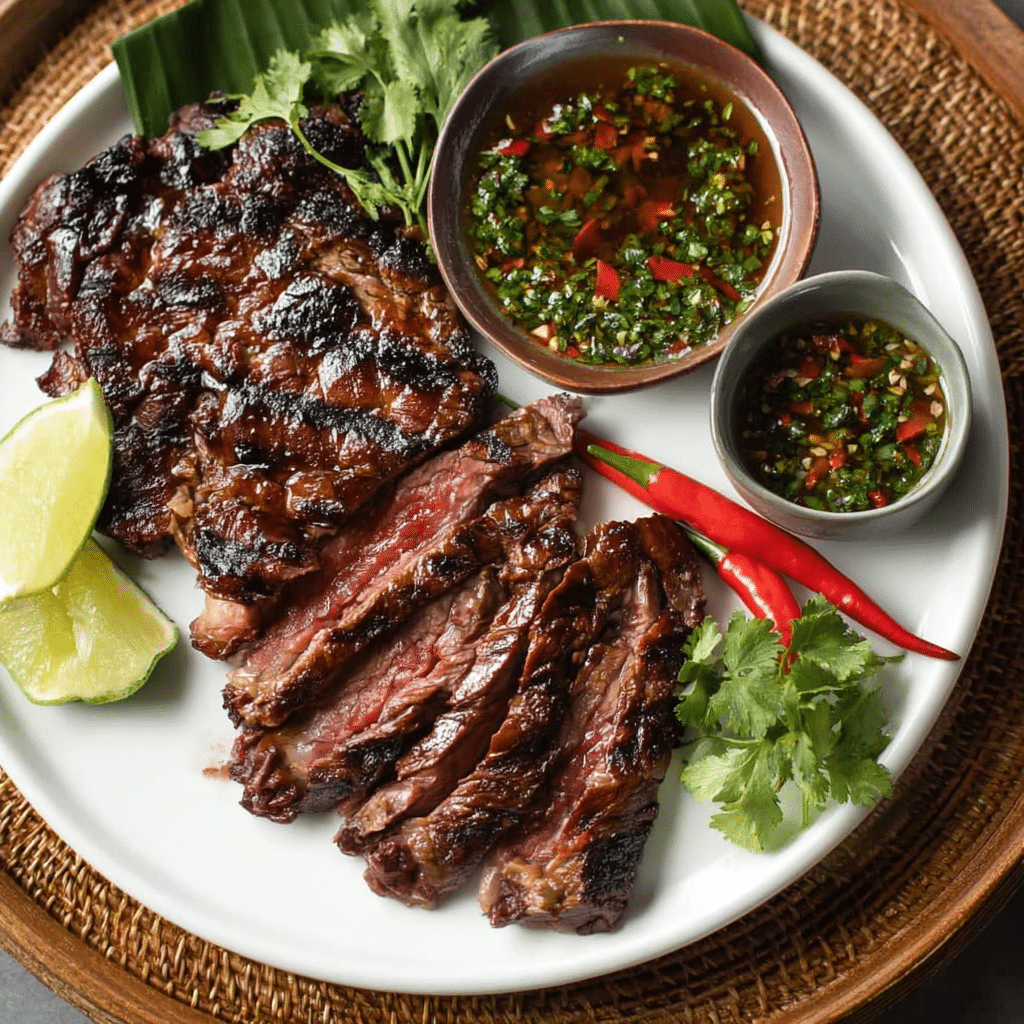Grilled Thai Crying Tiger Steak, or Seua Rong Hai, is a beloved street food staple in Thailand known for its bold flavors and smoky finish. The name alone sparks curiosity, and the taste delivers beyond expectations — tender slices of flank steak marinated in a savory umami-rich mix and grilled over high heat for that perfectly charred exterior.
This recipe is all about showcasing the natural richness of the beef, elevated by traditional Thai seasonings that bring balance and depth. Served with a side of sticky rice or crisp vegetables, it’s an uncomplicated yet unforgettable dish that’s perfect for outdoor cooking or a flavorful weeknight dinner.
Full Recipe
Ingredients:
-
1 lb flank steak (or sirloin)
-
1 tablespoon oyster sauce
-
1 tablespoon soy sauce
-
1 tablespoon fish sauce
-
1 teaspoon sugar
-
1 teaspoon ground white pepper
-
1 tablespoon vegetable oil
-
Optional: fresh cilantro and lime wedges for garnish
Directions:
-
In a mixing bowl, combine oyster sauce, soy sauce, fish sauce, sugar, ground white pepper, and vegetable oil.
-
Add the flank steak and coat it evenly with the marinade. Cover and refrigerate for at least 30 minutes (overnight for deeper flavor).
-
Preheat grill or grill pan to high heat.
-
Remove steak from the marinade and let excess drip off. Grill steak for 3–4 minutes per side for medium-rare or longer depending on your preferred doneness.
-
Transfer the steak to a cutting board and let it rest for 5 minutes.
-
Slice thinly against the grain. Garnish with chopped cilantro and lime wedges if desired.
-
Serve hot with sticky rice or fresh vegetables.
Prep Time: 10 minutes | Marinate Time: 30 minutes | Cooking Time: 10 minutes | Total Time: 50 minutes
Kcal: 285 kcal | Servings: 4 servings
Introduction to Grilled Thai Crying Tiger Steak
Grilled Thai Crying Tiger Steak, also known in Thai as Seua Rong Hai, is a legendary dish that originates from the Isaan region of northeastern Thailand. Its name, which translates literally to “Crying Tiger,” is as intriguing as the flavors it offers. While many romanticize the name with stories of tigers weeping over the loss of such a delicious meal, others believe the reference is to the way the beef “cries” when grilled—producing flavorful juices as it sizzles over the fire. Regardless of interpretation, one thing is certain: this dish is a celebration of fire, flavor, and finesse.
This Thai street food classic is beloved for its simplicity, yet it carries a powerful punch in terms of taste. The marinade, typically made with a bold blend of umami-rich sauces like soy, oyster, and fish sauce, works deeply into the meat, infusing it with savory intensity. When grilled, the beef develops a caramelized crust that locks in its juices, resulting in a dish that’s smoky, juicy, and irresistibly satisfying.
Cultural Significance in Thai Cuisine
In Thai culture, grilling meat is more than just a cooking method — it’s part of a social experience. Dishes like Crying Tiger are often served at communal gatherings, weekend family meals, and festive occasions. This dish represents the essence of Thai culinary philosophy: balance, boldness, and a respect for the ingredients.
Isaan cuisine, where this recipe hails from, is known for its rustic, hearty, and spicy character. Unlike the coconut milk–rich dishes of central and southern Thailand, Isaan food relies on grilling, fermentation, and sharp seasonings to highlight natural flavors. Crying Tiger Steak stands as one of the most accessible and popular dishes from this region, embodying the char-grilled flavors and protein-focused meals common in rural Thai households.
Why It’s Called “Crying Tiger”
The poetic name of the dish often piques curiosity. While the true origin remains debated, a widely shared tale tells of a tiger that cried after discovering hunters had already devoured the most tender part of the cow — the brisket or the underbelly. Another theory is that the steak’s juices resemble tears as they drip onto the fire, creating a smoky aroma that could make anyone emotional (or hungry). Though the story is mostly folkloric, it adds charm and a cultural touch to the dish’s appeal.
In modern kitchens, the name evokes a sense of drama and excitement, perfectly fitting a dish that delivers intense flavor and presentation. The steak is often served sliced thinly, arranged beautifully on a platter with garnishes like lime wedges, fresh herbs, and occasionally, sticky rice or raw vegetables.
Taste Profile and Flavor Layers
What makes Grilled Thai Crying Tiger Steak so memorable is its layered flavor profile. The marinade combines salty, sweet, and umami notes, which seep deep into the beef over time. When grilled at high heat, the sugars in the marinade caramelize to create a rich, slightly crispy crust. Inside, the meat remains juicy and tender, offering a delightful contrast in texture.
The grilled steak is bold, earthy, and smoky with a subtle hint of sweetness that balances out the saltiness of the fish and soy sauces. Though this version doesn’t include the traditional Nam Jim Jaew dipping sauce, the steak alone holds its own, especially when paired with the mild sweetness of sticky rice or the freshness of raw vegetables like cucumber or lettuce.
Choosing the Right Cut of Beef
Traditionally, flank steak or brisket is used for this recipe due to their flavor and texture. Flank steak, in particular, is ideal for grilling because it absorbs marinades well and becomes tender when sliced thinly against the grain. Sirloin or even ribeye can be used as alternatives for those who prefer a fattier or more tender cut.
The key to success is marinating the meat long enough to let the flavors penetrate deeply, and cooking it quickly over high heat to develop that crave-worthy char without overcooking the interior. Resting the steak after grilling is also essential, allowing the juices to redistribute and keep the meat moist and flavorful.
How It’s Served in Thailand
In Thailand, Crying Tiger Steak is typically served with warm sticky rice and raw vegetables on the side, like long beans, cabbage, or cucumbers. The pairing helps balance the richness of the beef with freshness and texture. Often, a small bowl of dipping sauce accompanies the dish, though this version of the recipe keeps the spotlight on the meat itself.
Presentation is important in Thai cuisine, and Crying Tiger is no exception. The steak is usually sliced thinly and fanned out on a plate, garnished with a few fresh herbs or chili flakes. It’s simple, rustic, and visually appealing — just like the street food stalls and countryside kitchens it comes from.
Perfect for Grilling Enthusiasts
This dish is a fantastic option for home cooks who love grilling but want to try something with a twist. It’s easy to prepare, doesn’t require fancy equipment, and gives a major payoff in flavor. The marinade can be prepped ahead of time, making it a great weeknight option, while the grilling process is fast and satisfying.
Whether cooked on a charcoal grill, gas grill, or stovetop grill pan, the results are consistently mouthwatering. The smoky aroma, sizzling sound, and seared exterior are all part of the experience. It’s a great introduction to Thai cooking for beginners and a must-try for seasoned grill masters.
Tips for Success
-
Marinate long enough: At least 30 minutes, but ideally overnight for deeper flavor.
-
Don’t skip the rest: Letting the steak rest after grilling ensures maximum juiciness.
-
Use high heat: This sears the outside and locks in the juices.
-
Slice against the grain: Ensures tenderness with every bite.
-
Pair it well: Sticky rice, cucumber, and a squeeze of lime make great accompaniments.
Health & Nutrition Perspective
Grilled Thai Crying Tiger Steak is relatively lean, especially when using flank or sirloin cuts. It’s high in protein, low in carbs, and packed with essential amino acids. Unlike deep-fried or heavily sauced dishes, this preparation relies on grilling — making it lighter and suitable for those watching their fat or calorie intake.
It can easily be adapted to fit different dietary preferences. For example, gluten-free versions can use tamari or coconut aminos in place of soy sauce. Paleo and keto eaters also appreciate its low-carb profile, while high-protein seekers enjoy it as a hearty main dish without compromise.
A Versatile Dish for All Occasions
Crying Tiger Steak is versatile enough to be served as a quick weeknight meal, an impressive party dish, or the centerpiece of a summer BBQ. Its balance of rustic charm and bold flavor makes it suitable for both casual and formal gatherings. It pairs beautifully with Southeast Asian sides but also fits into more Western-style meals with roasted vegetables or salad.
You can even make tacos or wraps using this steak as a filling — combining it with fresh herbs, pickled veggies, and a drizzle of lime for a fusion twist.
Conclusion
Grilled Thai Crying Tiger Steak is more than just a meal — it’s an experience that ties together tradition, flavor, and the thrill of open-flame cooking. With its roots in Thailand’s rural northeast, this dish has found global appeal thanks to its ease of preparation, robust taste, and showstopping presentation.
Whether you’re exploring Thai cuisine for the first time or deepening your culinary repertoire, this dish is an outstanding example of how simplicity, when done right, can deliver unforgettable flavor. It’s bold, smoky, deeply satisfying, and a surefire hit every time it hits the plate.
If you’re looking to add an international twist to your next grill night or impress guests with something new, Grilled Thai Crying Tiger Steak is a dish that delivers on every front.






